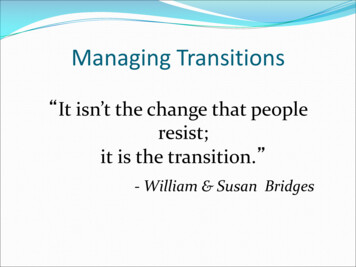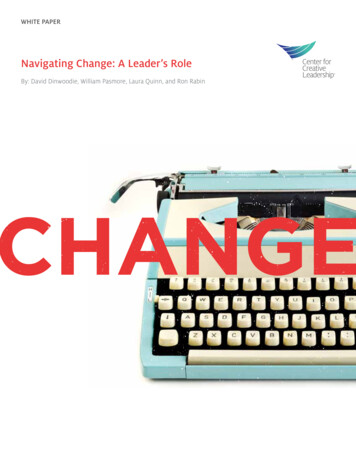
Transcription
Managing Transitions“It isn’t the change that peopleresist;it is the transition.”- William & Susan Bridges
Change vs.TransitionChange is situational:The move to a new site, assignment to a new team,new organizational structure, merger of two affiliates,changing strategies to incorporate NRITransition is psychological:Is the three-phase process people go through as theyinternalize and come to terms with the details of thenew situation.
Three Phases of Transition An Ending The Neutral Zone A New Beginning
An Ending The first phase of transition is an ending. Lettinggo of the old ways and the old identity. Results in a loss. People go through the stages of loss and grieving;that is, the natural sequence of emotions thatoccur when losing something that matters tothem.
The Neutral Zone The in-between time when the old is gone but the newisn’t fully operational. A chaotic time, lacking clear systems and signals. Bridges uses a “wilderness” metaphor whendescribing the Neutral Zone.
The Neutral ZoneIt’s not so much that we’re afraid of change or soin love with the old ways, but it’s that place inbetweenthat we fear it’s like being between trapezes. It’s Linus when hisblanket is in the dryer. There’s nothing for us tohold on to.”- Marilyn Ferguson
The Neutral ZoneDangerous because: Ambiguity causes anxiety to rise. Communication can break down. Productivity sags.Creative opportunity because:Break in normal routines providesopportunity to think of ways to do thingsdifferently or better.
A New Beginning When people develop the new identity, experiencethe new energy, and discover the new sense ofpurpose that makes the change begin to work. An emotional commitment to do things the newway. Can only occur after proceeding through theNeutral Zone
The Four PsTo make a new beginning, people need the four Ps: The Purpose A Picture The Plan A Part to Play
Managing the TransitionUnderstanding the process can help.A transition begins with letting go of something: anending. Endings result in loss; loss triggers grieving.Passing through the Neutral Zone is necessary for a newbeginning. The Neutral Zone can be a creativeopportunity.
Leading ChangeJ. P. Kotter -- 8 Steps to Address 8 Common FailuresStep #1: Establish a Sense of UrgencyStep #2: Create a Guiding CoalitionStep#3: Develop a Vision and StrategyStep #4: Communicate the Change VisionStep #5: Empower Employees for Broad-Based ActionStep #6: Generate Short-Term WinsStep #7: Consolidate Gains to Produce More ChangeStep #8: Anchoring New Approaches in the Culture
What is the purpose?“If you don’t know where you are going any road willtake you there.” Cheshire Cat in Alice in Wonderland How do we aspire to be different than we are now? What do we want to accomplish on this changejourney? What aspirations do we hold? Welcome lengthy debates and conflicts Invite people to shape specifics.
Who needs to be involved? Defines the natural boundaries of the system. Leadership only or various groups of stakeholders? Numbers are important. Rationales:? Buy-in and less resistance? More perspective and wisdom Possible invitees: Those who will be affected Those who can influence Those with resources to contribute
What conversations are needed?Conversations among stake-holders move theorganization toward the future it yearns to have.Change is more than an event: it is a journey thatunfolds as people come together.The journey continues after the event.Converge – diverge. Events allow a critical mass ofpeople to focus in “real time,” becoming aware of theirconnections, clarifying aspirations and agreeing onpathways.
“Change is disturbing when it isdone to us, exhilarating when itis done by us.”--Rosabeth Moss Kanter
Managing Transitions “ It isn’t the change that people resist; it is the transition. ” - William & Susan Bridges. William Bridges and Susan Bridges. Managing Transi










